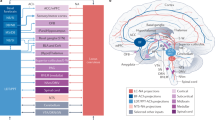Abstract
Three Rhesus monkeys restrained in primate chairs were exposed to several Pavlovian control procedures, followed by 13 sessions of cardiac conditioning under a delay paradigm. The conditional stimulus (CS) was a vertical line and the unconditional stimulus (US) was electric foot shock. Heart rate (HR) was analyzed in successive fivesecond intervals beginning five seconds before CS onset. The major finding was that the conditional response was consistently biphasic and consisted of an initial acceleration followed by deceleration toward the baseline, but rarely reaching it before onset of US. The subjects differed in magnitude of acceleration and subsequent deceleration as well as the location of the maximum rate in the CS-US interval. A breakdown of trials on the basis of the pre-CS HR revealed that the magnitude of effect was inversely related to the pre-CS rate.
Similar content being viewed by others
References
Banks, J. H., Jr., Miller, R. E., and Ogawa, N.: The development of discriminated autonomic and instrumental responses during avoidance conditioning in the rhesus monkey.J. Genet. Psychol. 108: 199–211, 1966.
Benjamin, L. S.: Facts and artifacts in using analysis of covariance to “undo” the law of initial values.Psychophysiology 4: 187–206, 1967.
Black, A. H., Carlson, N. J., and Solomon, R. L.: Exploratory studies on the conditioning of autonomic responses in curarized dogs.Psychol. Monogr. 76: (29, Whole No. 548), 1962.
Block, J. D., and Bridger, W. H.: The law of initial value in psychophysiology: A reformulation in terms of experimental and theoretical considerations.Ann. N. Y. Acad. Sci. 98: 1229–1241, 1962.
Church, R. M., LoLordo, V., Overmier, J. B., Solomon, R. L., and Turner, L. H.: Cardiac responses to shock in curarized dogs: effects of shock intensity and duration, warning signal, and prior experience with shock.J. Comp. Physiol. Psychol. 62: 1–7, 1966.
Cohen, D. H., and Durkovic, R. G.: Cardiac and respiratory conditioning, differentiation, and extinction in the pigeon.J. Exp. Anal. Psychol. 9: 681–688, 1966.
Gantt, W. H.: Cardiovascular components of the conditional reflex to pain, food and other stimuli.Physiol. Rev. 40: 266–291, 1960.
Geer, J. H.: Measurement of the conditioned cardiac response.J. Comp. Physiol. Psychol. 57: 426–433, 1964.
Hearst, E., Beer, B., Sheatz, G., and Galambos, R.: Some electrophysiological correlates of conditioning in the monkey.Electroenceph. Clin. Neurophysiol. 12: 137–152, 1960.
Jaworska, K., and Soltysik, S.: Studies on the aversive classical conditioning. 3. Cardiac responses to conditioned and unconditioned defensive (aversive) stimuli.Acta Biol. Exp. 22: 193–214, 1962.
Kosupkin, J. M., and Olmstead, J. M. D.: Slowing of the heart as a conditioned reflex in the rabbit.Amer. J. Physiol. 139: 550–552, 1943.
Lacey, J. I.: The evaluation of autonomic responses: Towards a general solution.Ann. N. Y. Acad. Sci. 67: 123–164, 1956.
Lynch, J. J.: Heart rate variability of dogs in classical conditioning.Psychol. Rep. 18: 101–106, 1968.
Nathan, M. A., and Smith, O. A., Jr.: Differential conditional emotional and cardiovascular responses—A training technique for monkeys.J. Exp. Anal. Behav. 11: 77–82, 1968.
Newton, J. E. O., and Gantt, W. H.: One-trial cardiac conditioning in dogs.Cond. Reflex 1: 251–265, 1966.
Newton, J. E. O., and Perez-Cruet, J.: Successive-beat analysis of cardiovascular orienting and conditional responses.Cond. Reflex 2: 37–55, 1967.
Ramsay, D. A.: Cardiac activity in the rhesus monkey under several classical conditioning procedures and operant avoidance. Unpublished doctoral dissertation, Columbia University, 1969.
Ramsay, D. A., Pomerleau, O. F., and Snapper, A. G.: Two methods for obtaining electrocardiograms of chair-restrained monkeys.Cond. Reflex 3: 200–204, 1968.
Shearn, D.: Does the heart learn?Psychol. Bull. 58: 452–458, 1961.
Smith, O. A., Jr., and Stebbins, W. C.: Conditioned blood flow and heart rate in monkeys.J. Comp. Physiol. Psychol. 59: 432–436, 1965.
Snapper, A. G., Pomerleau, O. F., and Schoenfeld, W. N.: Similarity of cardiac CR form in the rhesus monkey under several experimental procedures.Cond. Reflex, in press.
Weiss, B., and Laties, V. G.: A foot electrode for monkeys.J. Exp. Anal. Behav. 5: 535–536, 1962.
Wilder, J.: The law of initial value in neurology and psychiatry.J. Nerv. Ment. Dis. 125: 73–86, 1957.
Zeaman, D., and Smith, R. W.: Review of some recent findings in human cardiac conditioning.In W. F. Prokasy (ed.): Classical Conditioning: A Symposium. New York: Appleton-Century-Crofts, 1965.
Author information
Authors and Affiliations
Additional information
This study is based upon a dissertation submitted in partial fulfillment of the requirements for the Ph.D. degree at Columbia University. Supported in part by NIMH grant 13049 awarded to W. N. Schoenfeld, and by the Veterans Administration.
Rights and permissions
About this article
Cite this article
Ramsay, D.A. Form and characteristics of the cardiovascular conditional response in Rhesus monkeys. Conditional Reflex 5, 36–51 (1970). https://doi.org/10.1007/BF03000142
Issue Date:
DOI: https://doi.org/10.1007/BF03000142




